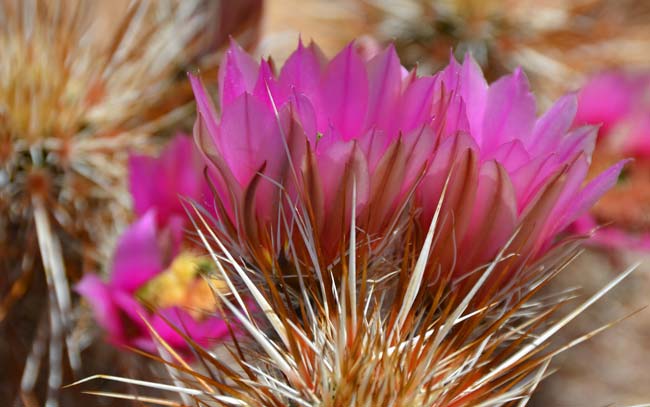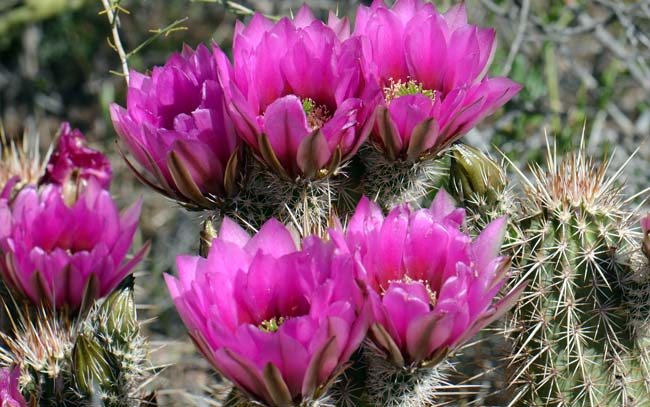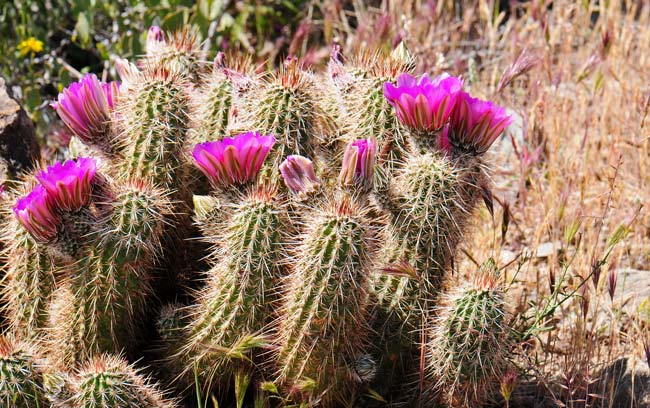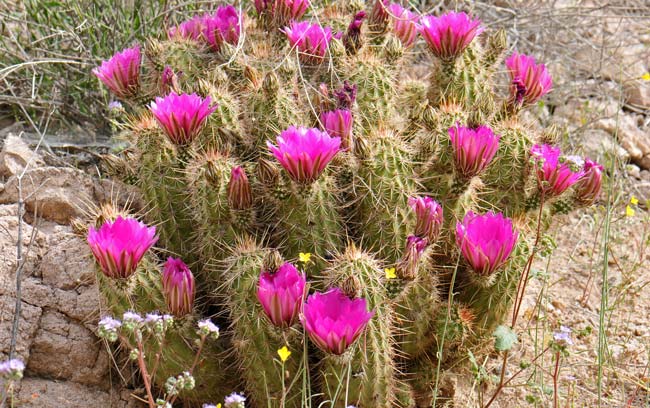Echinocereus engelmannii, Hedgehog Cactus




Scientific Name: Echinocereus engelmannii
Common Name: Engelmann's Hedgehog Cactus
Also Called: Calico Cactus, Engelmann Hedgehog, Hedgehog Cactus, Saints cactus, Strawberry Cactus, Strawberry Hedgehog, Strawberry Hedgehog Cactus, Purple Torch (Spanish: Sinita Barbona, Cacto Fresa, Pitahayita)
Family: Cactaceae, Cactus Family
Synonyms: ()
Status: Native
Duration: Perennial
Size: Up to 12 inches or so.
Growth Form: Shrub; clump-forming or loose open mounds; up to 60 stems.
Leaves: Leaves modified into spines, spines curved, red, yellow, white or gray. emerging from areoles; lacking glochids.
Flower Color: Bright rose-pink to magenta; flowers large and showy, tubular or short-funnel to bell-shaped, open during the day for several days; fruit matures red, fleshy, spiny, glabrous.
Flowering Season: February to June.
Elevation: Below 7,000 feet.
Habitat Preferences: Dry desert habitats.
Recorded Range: In the United States Echinocereus engelmannii is native to AZ, CA, NV, UT. It is also found throughout Baja California and northern Mexico. In Arizona it is found throughout most of the state.
North America & US County Distribution Map for Echinocereus engelmannii.
U.S. Weed Information: No information available.
Invasive/Noxious Weed Information: No information available.
Wetland Indicator: No information available.
Threatened/Endangered Information: Arizona: all varieties of Echinocereus engelmannii are salvage restricted; Nevada: Echinocereus engelmannii is protected as a Cactus, Yucca, or Christmas tree.
Genus Information: In North America there are 28 species for Echinocereus. Worldwide, The Plant List includes 64 accepted species names and a further 353 scientific names of infraspecific rank for the genus.
In the Southwestern United States: Arizona has 14 species of genus, California, Nevada and Utah each have 3 species, New Mexico has 12 species and Texas has 15 species. All data is approximate and subject to taxonomic changes.
There are 8 varieties in Echinocereus engelmannii:
Echinocereus engelmannii var. acicularis, Engelmann's Hedgehog Cactus (AZ, CA);
Echinocereus engelmannii var. armatus, Engelmann's Hedgehog Cactus (CA, NV);
Echinocereus engelmannii var. chrysocentrus, Engelmann's Hedgehog Cactus (AZ, CA, NV, UT);
Echinocereus engelmannii var. engelmannii, Engelmann's Hedgehog Cactus (AZ, CA, NV);
Echinocereus engelmannii var. howei, Howe's Hedgehog Cactus (AZ, CA, NV);
Echinocereus engelmannii var. munzii, Munz's Hedgehog Cactus (CA, NV);
Echinocereus engelmannii var. purpureus, Engelmann's Hedgehog Cactus (CA);
Echinocereus engelmannii var. variegatus, Engelmann's Hedgehog Cactus (AZ, UT).
Comments: Engelmann's Hedgehog Cactus is by far one of the most common hedgehog cactus in the Chihuahuan, Sonoran and Mojave Deserts. With 8 varieties it is clear that this species is highly variable and, at times, unclearly divided into varieties. Experts agree that further studies are needed.
Engelmann's Hedgehog Cactus is named in honor of George Engelmann (1809-1884), a German-American botanist instrumental in describing the flora of the west of North America. Mr. Engelmann was particularly active in the Rocky Mountains and northern Mexico.
In Southwest Desert Flora also see: Pinkflower Hedgehog, Echinocereus bonkerae, Scarlet Hedgehog Cactus, Echinocereus coccineus, Hedgehog Cactus, Pinkflower Hedgehog Cactus, Echinocereus fasciculatus and Rainbow Hedgehog Cactus, Echinocereus rigidissimus.
Hedgehog Cactus has been used for food by southwestern United States indigenous peoples.
See complete listing of ethno-botanical uses at Native American Ethnobotany, University of Michigan, Dearborn.

